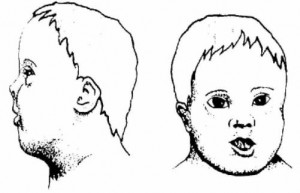a. Down’s syndrome is referred to as a chromosomal abnormality involving an extra chromosome (number 21).
It is characterized by a typical physical appearance and mental retardation. The extra chromosome is known as trisomy 21, an aberration in which chromosome 21 has three copies instead of the normal two because of faulty meiosis of the ovum or the sperm.
[otw_is sidebar=otw-sidebar-1]
It may be inherited or not inherited. Overall, it occurs in 1 per 650 live births. The incidence increases with maternal age, especially after age 35. Women over 35 years old account for bearing 50 percent of all children with Down’s syndrome. Paternal age doesn’t seem to play a significant part. This suggests that sometimes the chromosome abnormality responsible for Down’s syndrome results from deterioration of the oocyte because of age alone or because of the accumulated effects of environmental factors.
b. Signs and symptoms. See figure 11-4 for a typical Down’s syndrome child.
(1) Mental retardation is obvious as infants grow older.
(2) Marked hypotonia and floppiness.
(3) Joint hyperextension or hyperflexibility.
(4) Tendency to keep mouth open with his tongue protruding, high arched palate, and furrowed tongue.
(5) Eyes slant upwards and outward with internal epicanthal folds.
(6) Flattened nasal bridge and flat facial profile.
(7) Small ears, often incompletely developed, low set.
(8) Single transverse palmar crease-simian crease.

c. Diagnosis.
(1) Physical findings at birth.
(2) Karyotype (chromosomal analysis). This will show how the third chromosome, number 21, is attached to another autosome in terms of location or nondisjunction.
(3) Amniocentesis.
d. Treatment.
There is no known cure for Down’s syndrome. Surgery is available to correct heart defects and other congenital abnormalities. Antibiotic therapy for recurrent infections is also available.
e. Nursing intervention.
(1) Be careful and alert to infant’s feedings. Due to poor muscle tone and his protruding tongue, the infant may be a poor eater.
(2) Observe for complications that may occur with Down’s syndrome.
(a) Abdominal distention and vomiting.
(b) Irregularities in pulse of respiratory rate-cyanosis, tires easily with feeding.
(3) Support the infant and carefully position him.
(4) Provide proper stimulation to meet the infant’s needs-positive and effective sensory stimulation.
(5) Encourage parental participation in the infant’s care.
